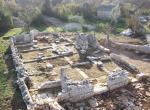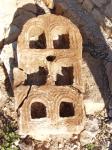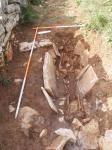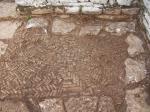Summary (English)
In October 2006, the third campaign of excavation of the three-nave basilica was carried out as part of the revisional investigation of the archaeological complex of Sv. Mihovil Banjolski (St. Michael of Banjole) located about 2 km northeast of the village of Peroj. With the works of 2006, the western third of the three-nave church and the narthex were excavated to the floor level, while the mound surrounded by drywall on the south side of the church was removed. As in the previously excavated parts of the church, the floor in the western part is made in the herringbone method (opus spicatum), with bricks (spicae) laid in various directions and combined with regularly carved stone blocks. The floor of the narthex is made of irregular stone slabs. Tombs mentioned in older literature (Rismondo 1910; Marušić 1967) were recorded in the narthex, but on this occasion, they were not investigated.
During the clearance of the mound on the south side of the church, which was partly created by the collapse of the church, and partly by the accumulation of material during previous excavations, a stone transenna and a fragment of a stone architrave, as well as a large number of fragments of frescoes, were found. Based on analogies, the transenna, measuring 31 × 65 cm, with three pairs of semicircular openings, can be dated to the early Christian period, while the fragment of stone architrave belongs to the group of pre-Romanesque architectural fragments.
At the end of the campaign, on the north side of the church, a grave with an inhumation burial and without grave goods was excavated. The grave is made of stone slabs. The deceased was laid in a supine position, with arms placed next to the body, and oriented west-east. As there were no grave goods, based on the type of grave construction, it can be assumed that it belongs to the period of the early Middle Ages. Future excavations should determine whether the church is surrounded by a cemetery. After the work was completed, the excavated area was covered with geotextile and base layer. The continuation of the works is planned for autumn 2007 (Martina Barada 2007, Hrvatski arheološki godišnjak 3/2006, 271–273).
- Martina Barada
Director
- Martina Barada
Team
Research Body
- Konzervatorski odjel u Puli
Funding Body
- Grada Vodnjan






![Download [PDF]](/excavation/skins/fasti/images/results/download_sml.png)


